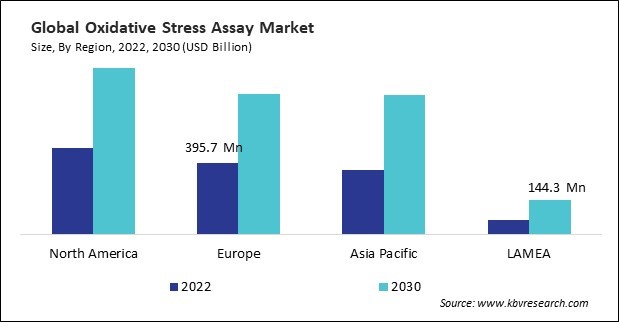According to a new report, published by KBV research, The Global Oxidative Stress Assay Market size is expected to reach $2 billion by 2030, rising at a market growth of 9.4% CAGR during the forecast period.
The Instruments segment is anticipating a CAGR of 9.8% during (2023 - 2030). Spectrophotometers and microplate readers measure absorbance, fluorescence, or luminescence signals in oxidative stress assays. These instruments enable quantifying reactive oxygen species (ROS), antioxidant capacity, and biomolecule oxidative damage. Their high sensitivity and versatility make them essential for various oxidative stress assays, contributing to precise and reproducible results.

The Indirect Assays segment dominated the Global Oxidative Stress Assay Market by Test Type in 2022; thereby, achieving a market value of $1.2 billion by 2030. Indirect assays measure a diverse range of biomarkers associated with oxidative stress. Indirect assays offer flexibility in experimental design. Indirect assays enable both quantitative and qualitative analysis of oxidative stress. Indirect assays provide insights into comprehensive cellular responses to oxidative stress. Indirect assays are well-suited for longitudinal studies and time-course analyses.
The Flow Cytometry segment would showcase a CAGR of 9.2% during (2023 - 2030). This capability enables simultaneous measurement of various parameters related to oxidative stress, such as intracellular ROS levels, mitochondrial membrane potential, and antioxidant enzyme activities. Researchers gain comprehensive insights into the complex cellular responses to oxidative stress. The analysis of thousands of cells per second facilitates screening extensive sample sets.
The Cardiovascular Disease segment is leading the Global Oxidative Stress Assay Market by Disease Type in 2022, thereby achieving a market value of $589.4 million by 2030. Reactive oxygen species (ROS) accumulation and compromised antioxidant defenses are key factors in the development of cardiovascular illnesses like heart failure, myocardial infarction, and atherosclerosis. The demand for oxidative stress assays is fueled by the demand to comprehend oxidative stress in cardiovascular pathology. Understanding oxidative stress in cardiovascular pathology fuels the demand for oxidative stress assays.
The Contract Research Organizations segment is registering a CAGR of 9.2% during (2023 - 2030). CROs often have dedicated teams of scientists with expertise in assay development, including oxidative stress assays. Their proficiency in designing and implementing assays tailored to specific research needs contributes to the market's growth. CROs tailor their services to the specific needs of their clients, providing flexibility in study design and execution.
Full Report: https://www.kbvresearch.com/oxidative-stress-assay-market/
The North America region dominated the Global Oxidative Stress Assay Market by Region in 2022, and would continue to be a dominant market till 2030; thereby, achieving a market value of $693.6 million by 2030. The Europe region is experiencing a CAGR of 9% during (2023 - 2030). Additionally, The Asia Pacific region would experience a CAGR of 10.2% during (2023 - 2030).
By Product
By Test Type
By Technology
By Disease Type
By End-user
 Unique Offerings
Unique Offerings